Among the most popular animals that have been populating the seas and beaches all over Italy for the past few years are definitely ... unicorns. You see them plying the waves (the smaller ones, not the big ones) with children on board, and even those a bit older, proud and happy to float on the water and entertain everyone at the same time. The more fashionable ones have a white body with a mane, tail and large rainbow-colored wings, and a distinctive horn, often yellow, between shining fawn eyes. However, the fantastic creature, also known as the lyocorn, depicted with the body of a horse and the typical long, spirally twisted horn sprouting from its forehead, has a long tradition and many times it is found depicted in coats of arms, including the royal coat of arms of the United Kingdom, the royal coat of arms of Scotland, and that of the Contrada del Leocorno of Siena; it is also the earliest symbol attributed to the House of Este, probably since in 949 a coat of arms with a golden unicorn on a blue background was given by Emperor Otto I to Albert Azzo d’Este, but most importantly one encounters the unicorn in numerous works of art. What meanings does this mythological animal take on throughout art history?
The first description of the unicorn in Western culture can be traced back to the Greek historian and physician to the Persian king Artaxerxes II, Ctesia of Knidos: “In India there are wild asses as big as horses and even bigger. They have white bodies, red heads and blue eyes. On their foreheads they have a long horn about a foot and a half long. The powder of this ground horn is taken in small doses as an antidote against deadly poisons. The base of the horn, about two palms above the forehead, is white; the other end is pointed and crimson; the middle part is black. It has the talus similar to that of the ox [...] It is an extraordinarily swift and mighty animal so that no creature, neither the horse nor any other, can surpass it.” The Greek historian found himself reporting, in all likelihood, a summary of the descriptions of travelers and merchants who had come in their explorations as far as India and Central Asia and had encountered rhinoceroses.
Claudius Elianus, a Greek-language Roman philosopher and writer who devoted himself to the nature of animals, also wrote in reference to the thaumaturgic power of the horn: “He who drinks from this horn is safe from all incurable diseases, such as convulsions and the so-called sacred disease, and cannot be killed by poison.” From these descriptions we understand how the unicorn was from the very beginning linked to a symbol of purity, since its horn was taken as a universal antidote against all poisons. The theory had originated from an early Christian legend, in which it was told that a snake, approaching a pool of water, poisoned it by spitting its poison into it; the other animals then awaited the arrival of a unicorn, which, after plunging into the water, drew the sign of the cross with its horn and every poisonous principle disappeared.
In addition to purely descriptive depictions of the unicorn in the bestiaries, texts particularly popular in the Middle Ages that collected descriptions of animals, both real and imaginary, flanked by related religious and moral interpretations, including the Bestiary of Aberdeen, the legendary creature appears in some representations related to Borso d’Este, emphasizing the thaumaturgical value of the horn. In fact, the unicorn is seen depicted in a miniature of the famous Bible of Borso d’Este, a precious illuminated codex commissioned by the latter in the mid-15th century to two of the greatest illuminators of the time, Taddeo Crivelli (Ferrara, 1425 - Bologna, 1479) and Franco dei Russi (Mantua, active in the 15th century), who made it in six years with the help of other artists. In Borso’s intent, the miniatures were to translate into images the most significant fe ats and exploits of which the Este family had been protagonists. Depicting the unicorn therefore referred back to the land reclamation works of the Ferrarese territory, begun by Leonello and continued by Borso himself. The animal is depicted here on a meadow, often enclosed by a hedge or fence to indicate a protected place, with a date tree behind it to emphasize the fertility of the reclaimed territories, while it dips its horn into water to purify it. The same symbol can then be seen on the marble portal of Palazzo Schifanoia in Ferrara, and in the same palace, in the frescoed Salone dei Mesi, two white unicorns, symbols of purity, pull Minerva’s throne in the Triumph of the Goddess in the Month of March, a masterpiece by Francesco del Cossa (Ferrara, 1436 - Bologna, 1478) completed between 1468 and 1470. And again, the unicorn is depicted in the Hall of Virtues as a symbol of purity.
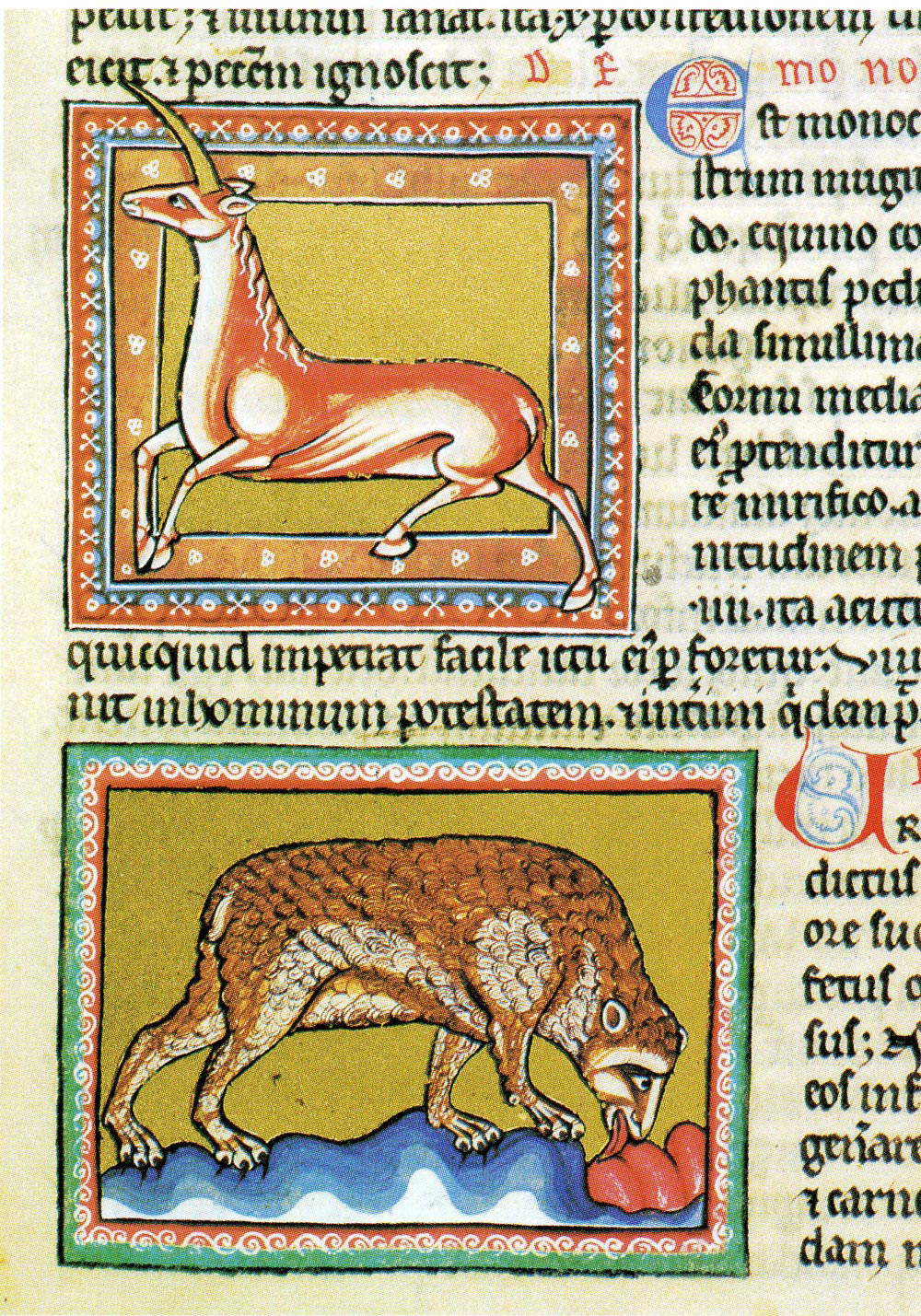 |
| English miniaturist, Unicorn and Bear, from the Ashmole Bestiary, f. 21r (early 13th century, Peterborough?; Oxford, Bodleian Library, Ms. Ashmole 1511) |
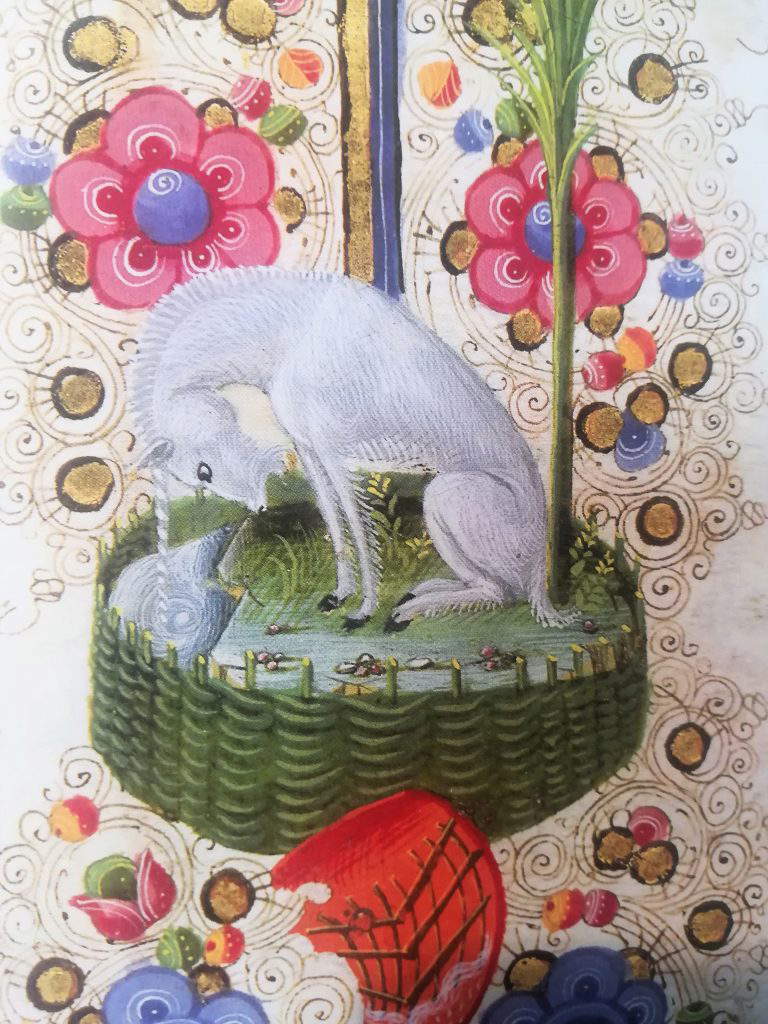 |
| Taddeo Crivelli and others, Unicorn, from the Bible of Borso d’Este (1455-1461; Modena, Biblioteca Estense, Ms. Lat. 422-423) |
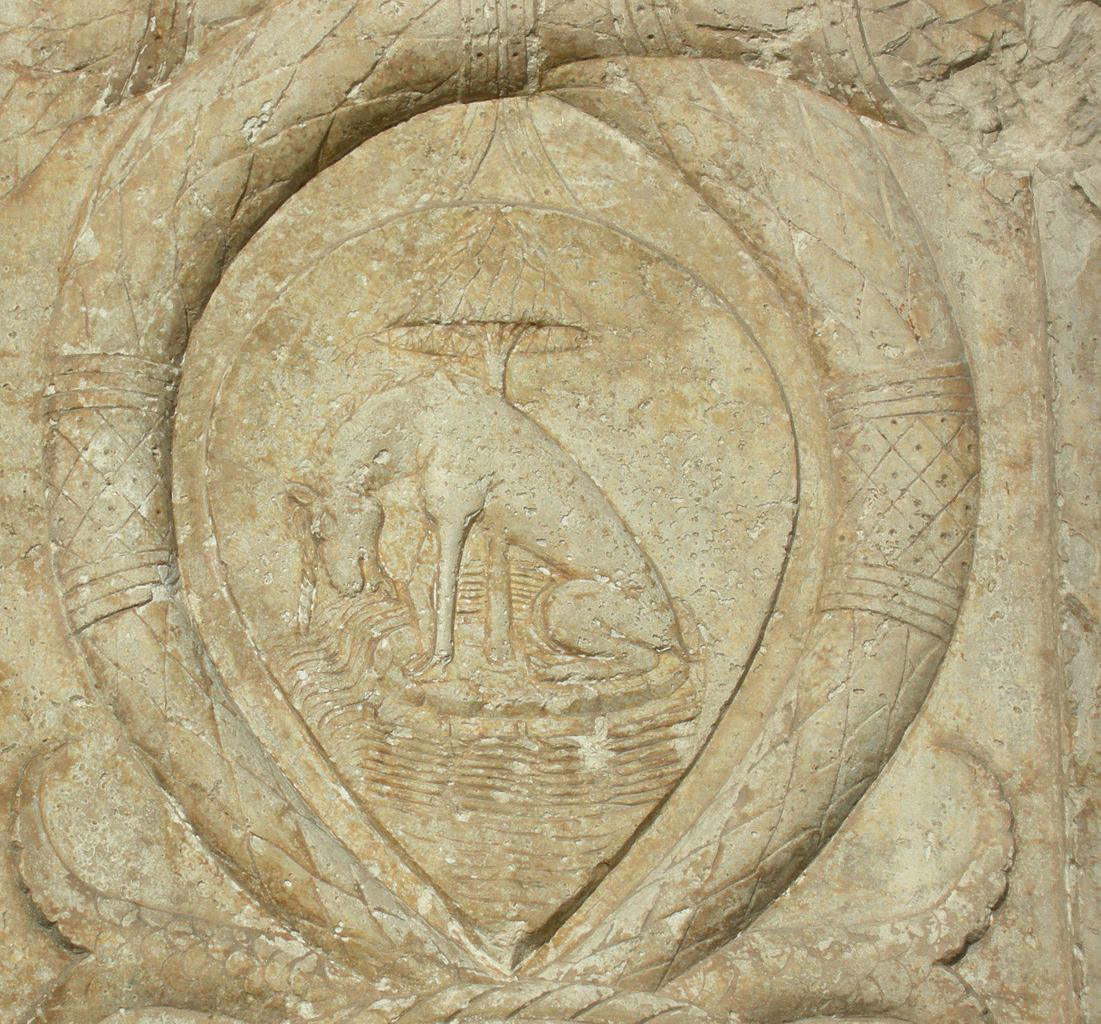 |
| Ambrogio di Giacomo da Milano and Antonio di Gregorio (based on a design by Pietro di Benvenuto degli Ordini), the unicorn on the portal of Palazzo Schifanoia, Ferrara (1470). Ph. Credit Nicola Quirico |
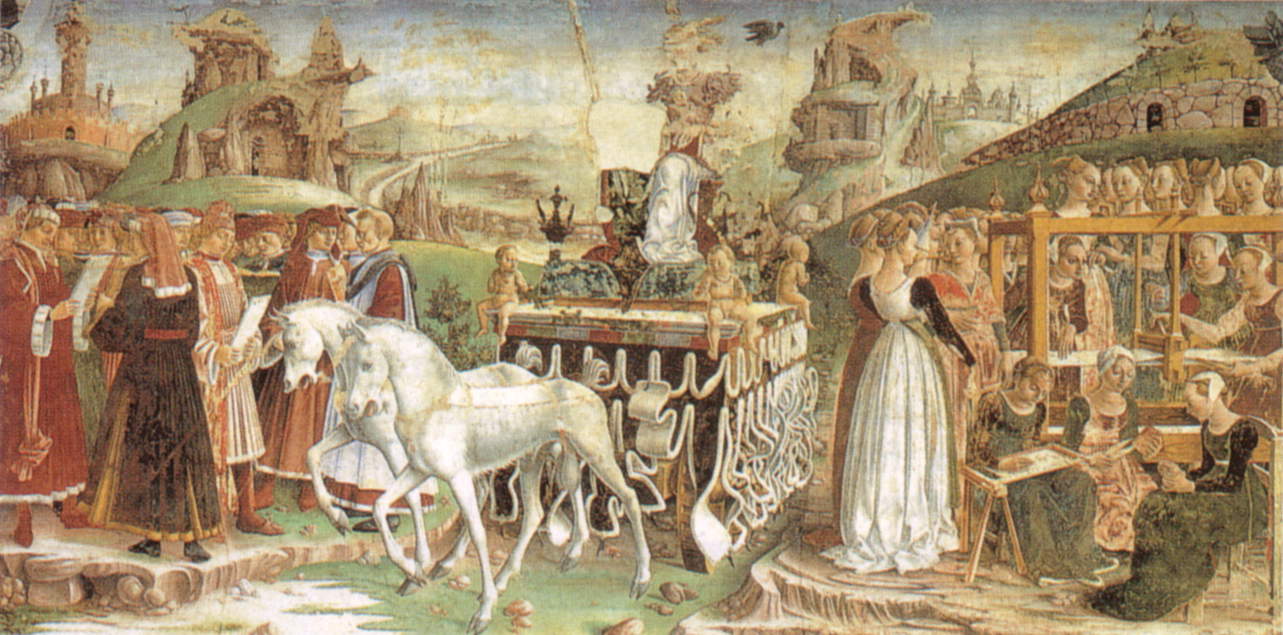 |
| Francesco del Cossa, Marzo, detail of the Triumph of Minerva (c. 1468-1470; fresco, 500 x 320 cm; Ferrara, Palazzo Schifanoia, Salone dei Mesi) |
It is also juxtaposed with the figure of Christ, thanks mainly to what is told in the Physiologus, a text dating back to the second century AD and coming from Alexandria, Egypt, written by a hypothetical naturalist Physiologus, which contains symbolic descriptions of animals, plants and some stones, through quotations from the Holy Scriptures. About the unicorn, Physiologus quoted Psalm 91: “And it shall be lifted up as that of the unicorn my horn” [Ps 91 (92):11]. The Physiologist said of the unicorn that it has this nature, “It is a small animal, similar to the kid, but most ferocious. The hunter cannot approach it because of its extraordinary strength: it has only one horn in the middle of its head. So how do they hunt it? They expose before it an immaculate virgin, and the animal leaps into the virgin’s breast, and she suckles it, and leads it to the king’s palace. The unicorn is an image of the Savior: for ’he raised up a horn in the house of David our father, and became for us a horn of salvation’ [Lk 1:69]. He took up residence in the womb of the true and immaculate Virgin Mary, ’and the Word became flesh, and dwelt among us’[Jn 1:14].”
Very common in art is the depiction of the unicorn next to a maiden, particularly a virgin, as an allegory of chastity. This derives precisely from the account in the Physiologus that only an immaculate virgin is capable of taming the unicorn. Among these depictions is the cycle of Flemish tapestries made in the late 15th century and consisting of six panels on a red background: five of these are dedicated to the senses, while the last My Only Desire presents the lady in front of a curtain held open by a unicorn and a lion and she places a necklace in a casket placed for her by her handmaiden. The cycle, preserved at the Musée de Cluny in Paris, was commissioned by Jean Le Viste, a personage close to the court of King Charles VII, and was discovered in 1841 by Prosper Mérimée in the Château de Boussac. Purchased in 1882 by collector Edmond Du Sommerard, studies have made it possible to identify the origin, iconography, and style of the tapestries. In the center are always the lady, unicorn and lion, and around them small animals create a world of harmony.
Also preserved in the collections of Castel Sant’Angelo is a painting by Luca Longhi (Ravenna, 1507 - 1580) depicting a Young Woman with Unicorn, made between 1535 and 1540. A maiden immersed in an idyllic landscape is seated next to a unicorn: the latter looks at her intently, while the girl points at it, turning her gaze toward the viewer. It is thought that the maiden depicted is actually Giulia Farnese, sister of Pope Paul III, who is portrayed here to emphasize her belonging to the Farnese family, as the virgin with the unicorn, besides being an emblem of purity, was a symbol of the same family for two generations already. The painting is also a post mortem celebration of Giulia Farnese, desired by the family members who commissioned it from the artist; in fact, Longhi executed the work after the young woman’s death in 1524. The composition is derived from a drawing by Leonardo da Vinci (Anchiano, 1452 - Amboise, 1519) kept at theAshmolean Museum in Oxford.
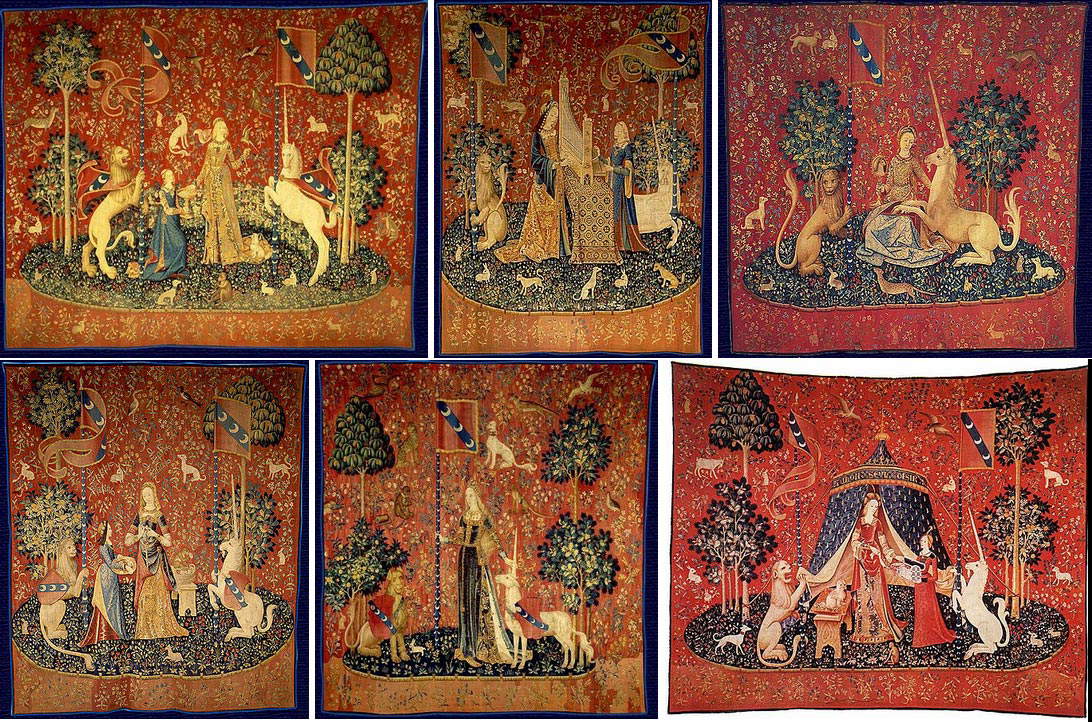 |
| Flemish artist, The Lady and the Unicorn (c. 1500; cycle of six tapestries, various sizes; Paris, Musée national du Moyen �?ge). Clockwise from left: taste, hearing, sight, A mon seul désir, touch, smell. |
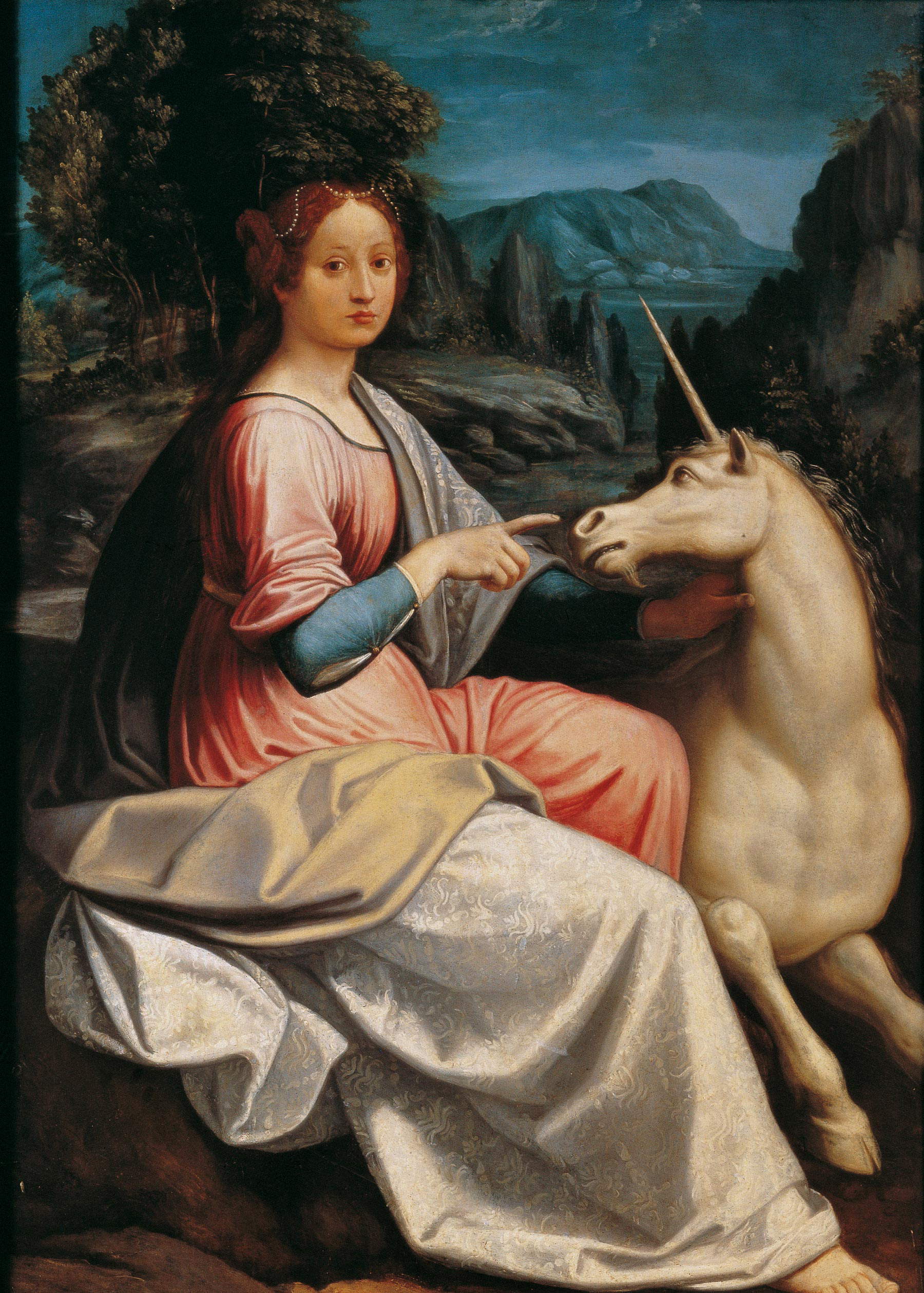 |
| Luca Longhi, Young Woman with Unicorn (1535-1540; oil on panel, 132 x 98 cm; Rome, Museo Nazionale di Castel Sant’Angelo) |
 |
| Domenichino, The Maiden and the Unicorn (c. 1620; fresco; Rome, Palazzo Farnese) |
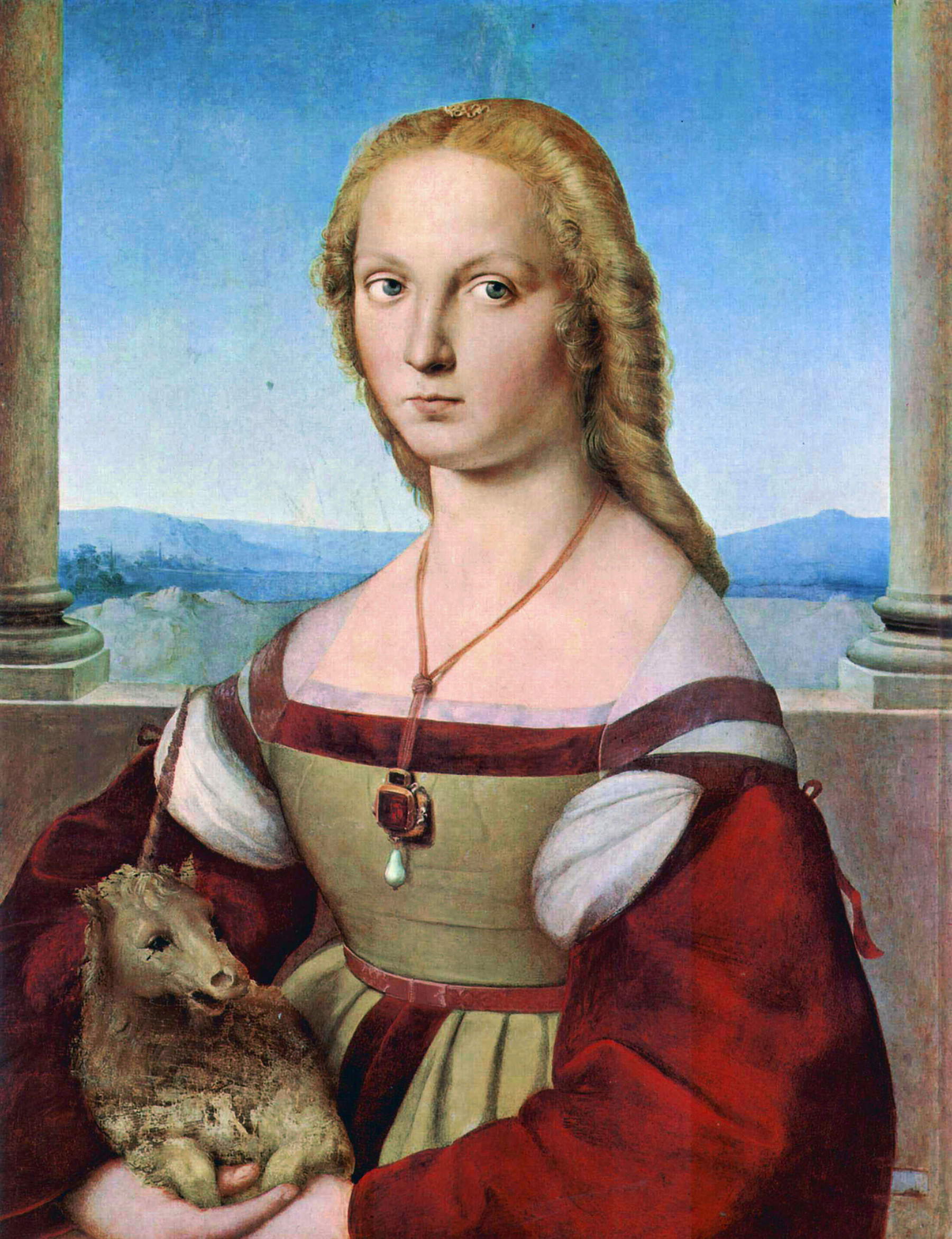 |
| Raphael, Lady with the Unicorn (c. 1505-1506; oil on panel, 65 x 51 cm; Rome, Galleria Borghese) |
Also immersed in an idealized landscape is the Maiden with the Unicorn that Domenichino (Domenico Zampieri; Bologna, 1581 - Naples, 1641) frescoed between 1604 and 1605 on the entrance door of the Galleria di Palazzo Farnese in Rome, under the guidance of Annibale Carracci (Bologna, 1560 - Rome, 1609). Here the maiden is sitting under a tree and tenderly embracing a unicorn that rests its front legs on her knees and its snout on her breast. A scene of intimate taming. The maiden’s gaze is not directed at the viewer in this case; it is a gaze absorbed in emptiness, and the viewer witnesses the sweet scene.
Even more famous is the Lady with a Unicorn by Raphael (Urbino, 1483 - Rome, 1520), painted between 1504 and 1505 and preserved in the Galleria Borghese. The identity of the young woman depicted and the commissioner are still unknown, but this is probably the first portrait of a woman painted by the Urbino artist. The maiden has blond hair flowing down to her shoulders, blue eyes and full cheeks, and stares fixedly at the viewer; she is an angelic figure holding a small unicorn. The dress with wide, removable sleeves and the splendid pendant jewelry (a ruby with pearl) around her neck suggest a young noblewoman. She has often been likened to Maddalena Strozzi, wife of Agnolo Doni, and perhaps the jewel is a clue since Doni’s passion for jewelry and his collection of gems is well known. The female figure is half-length and seated in front of the parapet of a terrace with columns, and in the background we can recognize a lake landscape. Also curious is the fact that originally Raphael painted a dog instead of the little unicorn, and this too could be an identifying clue, since the Strozzi family resided in the Gonfalone dell’Unicorno in the Santa Maria Novella district. It still remains a hypothesis, however.
Considering the fantastic creature’s ability to purify and remove all poison from water, the presence of all these unicorns on our seas is not so absurd: will they be able to solve the ever-present problem of marine pollution for good?
Bibliography
Warning: the translation into English of the original Italian article was created using automatic tools. We undertake to review all articles, but we do not guarantee the total absence of inaccuracies in the translation due to the program. You can find the original by clicking on the ITA button. If you find any mistake,please contact us.